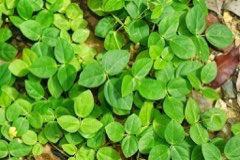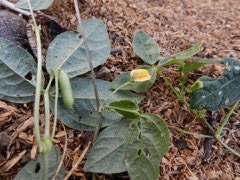 |
|
plantasdepuertorico.blogspot.com.au |
 |
| kanoak flickr |
Translate this page:
Summary
Sarawak Bean, Vigna hosei, is a perennial plant producing twining stems 1-2 m long that scrambles over the ground or twine into any surrounding vegetation. Although no plant part is edible and of medicinal important, the plant is an excellent ground cover and green manure crop. Seedling growth is vigorous and young plants quickly suppress growth of weed. It also has the ability to fix atmospheric nitrogen, hence it enriches the oil and promotes plant growth.
Physical Characteristics

 Vigna hosei is a PERENNIAL CLIMBER growing to 1 m (3ft 3in) by 0.2 m (0ft 8in) at a fast rate.
Vigna hosei is a PERENNIAL CLIMBER growing to 1 m (3ft 3in) by 0.2 m (0ft 8in) at a fast rate.
See above for USDA hardiness. It is hardy to UK zone 10. The plant is self-fertile.
It can fix Nitrogen.
Suitable for: light (sandy), medium (loamy) and heavy (clay) soils. Suitable pH: mildly acid soils and can grow in very acid soils.
It can grow in semi-shade (light woodland) or no shade. It prefers moist or wet soil.
UK Hardiness Map
US Hardiness Map
Synonyms
Dolichos hosei Craib Vigna oligosperma Backer Vigna parkeri acutifolia Verdc. Vigna parkeri acutifol
Plant Habitats
Edible Uses
References More on Edible Uses
Medicinal Uses
Plants For A Future can not take any responsibility for any adverse effects from the use of plants. Always seek advice from a professional before using a plant medicinally.
None known
References More on Medicinal Uses
The Bookshop: Edible Plant Books
Our Latest books on Perennial Plants For Food Forests and Permaculture Gardens in paperback or digital formats.

Edible Tropical Plants
Food Forest Plants for Hotter Conditions: 250+ Plants For Tropical Food Forests & Permaculture Gardens.
More

Edible Temperate Plants
Plants for Your Food Forest: 500 Plants for Temperate Food Forests & Permaculture Gardens.
More

More Books
PFAF have eight books available in paperback and digital formats. Browse the shop for more information.
Shop Now
Other Uses
Green manure Soil stabilization
Agroforestry Uses: The plant is used as a green manure and ground cover crop in young tree plantations, and also in rubber, tea and coconut plantations. Seedling growth is vigorous and young plants quickly suppress weed growth, forming a thick mat of growth with a dense leaf litter, which protects the soil from erosion and prevents the ingress of weeds. Its ability to fix atmospheric nitrogen enriches the soil and promotes the growth of the trees[310 , K ]. Due to its persistence under shade, the plant can enrich a mixture of leguminous covers for young plantation trees. Being a low-growing creeper, it hardly climbs trees, which is considered important for a good cover crop[310 ]. The plant is also being trialled as a green manure in association with annual crops[310 ]. When sown as a cover crop it may be mixed with other leguminous covers such as Calopogonium mucunoides, Centrosema pubescens and Pueraria phaseoloides[310 ]. Other Uses None known
Special Uses
Food Forest Ground Cover Nitrogen Fixer
References More on Other Uses
Cultivation details
A plant of the wet tropics, where it is found at elevations up to 1,100 metres. It grows best in areas where annual daytime temperatures are within the range 22 - 30°c, but can tolerate 15 - 35°c[418 ]. It does not tolerate frosts. It prefers a mean annual rainfall in the range 3,000 - 3,500mm, but tolerates 2,500 - 4,000mm[418 ]. Succeeds in full sun and in light shade[418 ]. Succeeds in sandy to clayey soils and is tolerant of occasional waterlogging[418 ]. Prefers a pH in the range 4.5 - 5, tolerating 4 - 5.5[418 ]. The plant has a shallow root system and a low tolerance of drought[310 ]. Flowering commences about 6 months after planting, self-pollination is the rule[310 ]. An outstanding characteristic of the plant is its persistence under shade, but full sunlight is required for good seed production[310 ]. Seed production is often poor and only about 50 kilos per hectare can be harvested. Harvesting the seed on a field scale is also difficult[310 ]. Besides producing normal aerial flowers and pods, the plant also produces flowers and pods which are hidden under the litter of leaves covering the soil[310 ]. A ground cover of Vigna hosei can be removed easily by hoeing the soil, followed by a clean weeding[310 ]. This species has a symbiotic relationship with certain soil bacteria, these bacteria form nodules on the roots and fix atmospheric nitrogen. Some of this nitrogen is utilized by the growing plant but some can also be used by other plants growing nearby. Although non-specific in its Rhizobium requirement, inoculation is preferably carried out with a selected cowpea strain such as CB 756[310 , 755 ].
References Carbon Farming Information and Carbon Sequestration Information
Temperature Converter
Type a value in the Celsius field to convert the value to Fahrenheit:
Fahrenheit:
The PFAF Bookshop
Plants For A Future have a number of books available in paperback and digital form. Book titles include Edible Plants, Edible Perennials, Edible Trees,Edible Shrubs, Woodland Gardening, and Temperate Food Forest Plants. Our new book is Food Forest Plants For Hotter Conditions (Tropical and Sub-Tropical).
Shop Now
Plant Propagation
Seed - it has a hard seedcoat and may benefit from scarification before sowing to speed up germination. This can usually be done by pouring a small amount of nearly boiling water on the seeds (being careful not to cook them!) and then soaking them for 12 - 24 hours in warm water. By this time they should have imbibed moisture and swollen - if they have not, then carefully make a nick in the seedcoat (being careful not to damage the embryo) and soak for a further 12 hours before sowing. Prior to sowing, the seeds may be inoculated with compost containing an appropriate Rhizobium strain[310 ] Cuttings - it is recommended to plant during the rainy season and to use 20cm long, 3-noded cuttings planted 100 - 150cm apart[310 ].
Other Names
If available other names are mentioned here
Native Plant Search
Search over 900 plants ideal for food forests and permaculture gardens. Filter to search native plants to your area. The plants selected are the plants in our book 'Plants For Your Food Forest: 500 Plants for Temperate Food Forests and Permaculture Gardens, as well as plants chosen for our forthcoming related books for Tropical/Hot Wet Climates and Mediterranean/Hot Dry Climates. Native Plant Search
Found In
Countries where the plant has been found are listed here if the information is available
Weed Potential
Right plant wrong place. We are currently updating this section.
Please note that a plant may be invasive in one area but may not in your area so it’s worth checking.
Conservation Status
IUCN Red List of Threatened Plants Status : Status: Data Deficient

Growth: S = slow M = medium F = fast. Soil: L = light (sandy) M = medium H = heavy (clay). pH: A = acid N = neutral B = basic (alkaline). Shade: F = full shade S = semi-shade N = no shade. Moisture: D = dry M = Moist We = wet Wa = water.

Expert comment
Author
(Craib) Backer
Botanical References
Links / References
For a list of references used on this page please go here
A special thanks to Ken Fern for some of the information used on this page.
Readers comment
| Add a comment |
|
If you have important information about this plant that may help other users please add a comment or link below. Only comments or links that are felt to be directly relevant to a plant will be included. If you think a comment/link or information contained on this page is inaccurate or misleading we would welcome your feedback at [email protected]. If you have questions about a plant please use the Forum on this website as we do not have the resources to answer questions ourselves.
* Please note: the comments by website users are not necessarily those held by PFAF and may give misleading or inaccurate information.
To leave a comment please Register or login here All comments need to be approved so will not appear immediately.
|
|